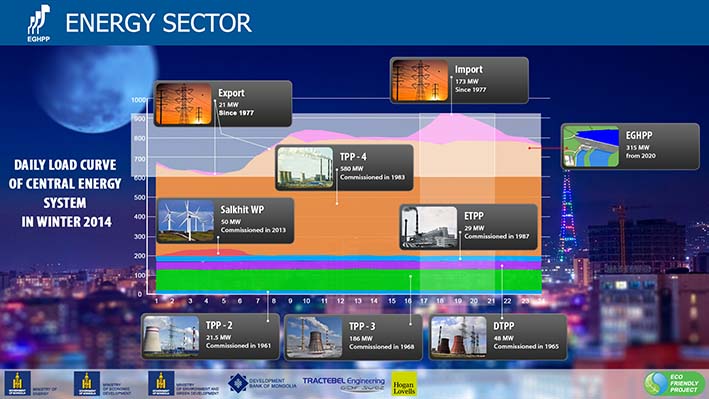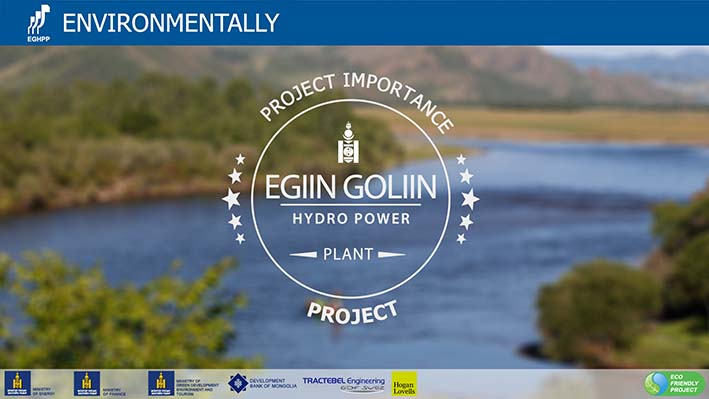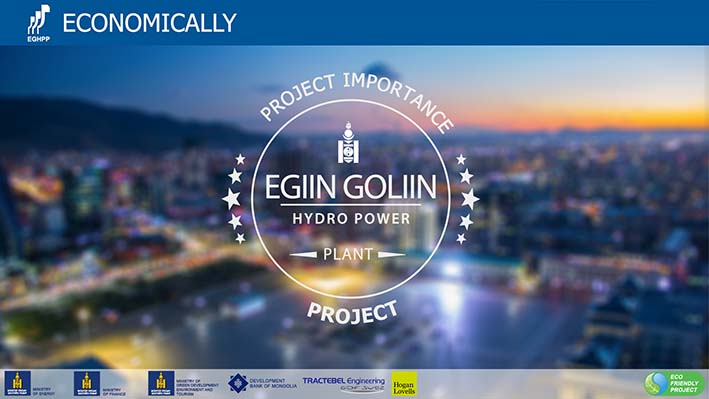- The operation of the EGHPP will contribute to the central energy system of Mongolia hence it will be independent from foreign countries.
- Egiin Goliin Hydro power plant will be the 1st high capacity hydro power plant in Mongolia.
- In 2015, total demand of electricity will exceed over supply.
- Egiin Goliin hydro power plant is one of the highly possible variation which can replace import of electricity.
- Central energy system of Mongolia imports annually $ 25 mln of electricity.
- Egiin Goliin hydro power plant will guarantee the national security of electricity.
- According to the geological study, the EGHPP geological condition of the dam foundation is found to be very agreeable.
- In November 2013, the Government of Mongolia passed resolution to start the construction of Egiin Goliin hydro power plant.
- Over the years total cost of the building power plant is increasing.
- The EGHPP is located at the confluence of Egiin and Selenge river 2.5km upstream.
- Construction of EGHPP will open opportunities of farming the water birds, fish and sable breeding.
- To fill the reservoir with water during summer and to generate electricity during winter.
- In the area of Egiin Goliin hydro power plant, annual precipitation is between 300 and 310 mm.
- In the area of Egiin Goliin hydro power plant, average temperature in December is -40 C, in July and August are +25 C.
- An ice phenomena of EGHPP, will be at its highest in December will reach 1.5m.
- In the area of Egiin Goliin hydro power plant, mean wind speed is 2.3 m/sec, humidity level is 72%.
- Since 1977, Mongolia paid $311 mln which equals to 451 bln of tugrugs on electricity imported from Russian Federation.
- Start up minutes of hydro power plant is 2-5 minutes in contrast to Thermal power plant 2-4 hours.
- Central energy system’s daily load during the winter is 776-800 MW.
- The EGHPP generated energy will be connected to the CES via 2 circuits double conductors with capacity of 220 kV.
- The main criteria for meeting the environmental objective are avoided of carbon dioxide (CO2) emissions, and the specific carbon offset of the project is determined in terms of carbon dioxide (CO2) emissions avoided per GWh over the lifetime of the project and thus EGHPP reduces 709 thousand ton of CO2 annually.
- By 2022,EGHPP is to produce 581 million kWh annually at minimum and the annual electricity generation is to vary between 581 to 2662 million kWh.
- By the April 2014 investigative study discovered 218 artifacts at the hydropower plant DAM SITE (910м), and 24 artifacts at the infrastructure route.
- 242 artifacts are planned to be excavated and preserved in 2014-2015.
- 423 species of plants grow at the Egiin Goliin DAM SITE.
- Hydropower costs less than most energy sources.
- Renewable Energy creates three-times more jobs than fossil fuels.
- In 1878 the world's first hydroelectric power scheme was developed at Cragside in Northumberland, England by William George Armstrong.
- Hydropower today provides about 20 % of the world's electricity and is the main energy source for more than 30 countries.
- Hydropower facilities can quickly go from zero power to maximum output, making them ideal for meeting sudden changes in demand for electricity.
- Hydropower can also be used for water supply, flood control, irrigation and even recreation purposes.
- The financial status of the hydroelectric industry is generally healthy due to long equipment life and low maintenance and operating costs.
- Egiin Goliin hydropower plant is estimated to cover the investment in 20-25 years of time with its sales income.
- Thermal power plants in UB city burns 3.5 million tons of raw coal, pollutes the air with 4 tons of coal, 4.5 million cubic meters of gas and 6kg emissions of sulfur gas.
- The Eg river is Mongolia's third largest river, and at the proposed dam site has a catchment area of about 40,000 km².
- Due to Mongolian country characteristics and situation, the value of 315 MW installed capacity has been selected.
- There are 21 types of fish at the Eg river.
- The new bridge that will be built across River Selenge will be a steel concrete bridge.
- Turbines and generators are expected to be replaced after 32 years of operation.
- Peak demand of the Mongolian energy system reached 948 MW, exceeding both installed and feasible generation capacity and the reason for increased imports of electricity
- Electricity is imported from Russia to the Central Region Integrated System via Selendum sub-station Russia and Darkhan sub-station Mongolia.
-
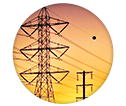
Coal fired power plants operate at base regime thus, it is technically limited in operating in line with changes in demand and regulate its generation in a short period of time; The energy imported from Russia covers the system’s peak load and operates as the regulator of the system. Thus, energy dependency on Russia is expected to accelerate. For instance, import electricity transmission line has reached its technical capability; Currently, daily peak load and base load difference is picking up to 320 MW as household dominated electricity consumption growth surges.
-

In utilising hydropower, climate change and air pollution will be reduced which will contribute in supporting green development, and generating environmentally friendly clean electricity; Furthermore, it reduces the use of raw coal, emissions of greenhouse gases released into the air in particular important areas of Ulaanbaatar and other urban areas.
-
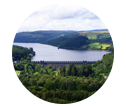
As the constantly renewable freshwater lake forms water, it would not only create large water reserve also increases the humidity of the region’s climate which would protect against desertification, create the opportunity to develop agricultural production and intensive farming activities. After the construction of the hydropower plant, formation of the lake would create favorable condition to develop tourism, water sports. Therefore the area has full potential of a development hub which would attract local and foreign tourists.
-

The peak load hydropower plant will the Mongolian first power plant with regulatory regime. The characteristics of the energy sector is that it generates according to the consumption momentum. The basis for sustainable energy system is that the system frequency to be stable. In order to configure the system frequency, the system requires to have backup power reserve capacity and also a regulator suited for consumption demand.
-
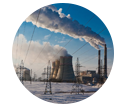
Increase the efficiency of the existing power plants as the hydropower plant maneuvering capability allows for eliminating Coal-fired power plants’ excess generation. Egiin goliin HPP only consumes 1% of its total generation for internal operations. In comparison, Coal-fired power plants use up to 20%.
-
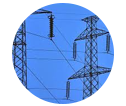
Reduce import energy dependence. Since the Russian federation’s 220 kV double circuit electricity overhead transmission line came into operation in 1977, the central region integrated energy system (CES) has established import agreement and it is still in effect till today. In 2013, 325.3 million kWh electricity has been imported from the Russian federation that is 6.3% of the total consumption.
-
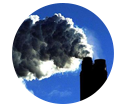
Decrease carbon emission. In accordance with the UN climate change convention and Kyoto protocol, Hydropower plant purpose is to reduce carbon emission. Mongolia has joined the convention. The main requirement of the convention is to generate power in compliance with environmental requirements and also assessed by avoided carbon emission per MWh. The hydropower plant annual 606 GWh electricity generation is estimated to avoid 709 thousand CO2 annually. Based on the calculation of the Energy Research and Development Center of the Ministry of Fuel and Energy of Mongolia, an emission factor of 1.17 ton CO2/MWh for coal-fired thermal generation has been utilised in the estimation. EGHPP Carbon abatement from developed countries is being studied at this stage. In reference to previous projects implemented in Mongolia, if the carbon abatement per ton carbon emission avoided is 4 Euros then EGHPP could earn 2.8 million Euros annually.
DAM SITE
-
THE DAM SITE IS LOCATED
2.5 KM FROM THE CONFLUENCE OF THE EG-SELENGE river in KHUTAG-UNDUR SOUM, BULGAN PROVINCE.
RESERVOIR
-
NORMAL WATER LEVEL
910 M A.S.L -
VOLUME AT NORMAL WATER LEVEL
5.7 BILLION m3 -
SURFACE AREA
154.3 KM2
DAM
-
DAM CREST LEVEL
912 M A.S.L -
DAM CREST WIDTH
8 м -
DAM CREST LENGTH
740 M -
DAM HEIGHT ABOVE NATURAL GROUND
82 м -
DAM VOLUME
2.29 MILLION m3
POWER HOUSE
-
INSTALLED CAPACITY
315 МW -
ANNUAL ELECTRICITY PRODUCTION
606 MILLION KWh -
TURBINE
FRANCIS 4 X 68.78 MW, 2 X 20.5 MW, 1 X 3 MW
PROJECT INFRASTRUCTURE
-
FROM THE DAM SITE TO THE ERDENET SUBSTATION
72.3 KM DOUBLE CIRCUIT 220KV TRANSMISSION LINE -
FROM THE DAM SITE TO THE ERDENET CITY
71.9 KM ACCESS ROAD, 320 M LONG REINFORCED CONCRETE BRIDGE OVER THE SELENGE RIVER


